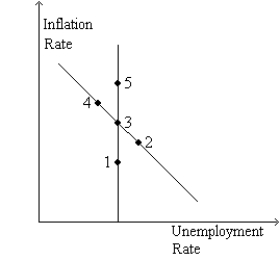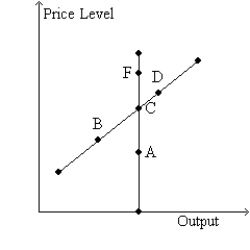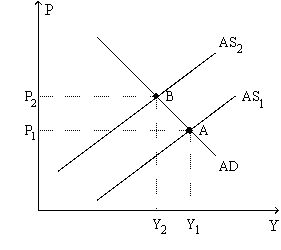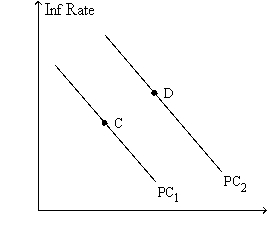A) the unemployment rate will be below its natural rate whenever inflation is negative.
B) the unemployment rate will be below its natural rate whenever inflation is positive.
C) the unemployment rate will be below its natural rate only if inflation is less than expected.
D) the unemployment rate will be below its natural rate only if inflation is greater than expected.
Correct Answer

verified
Correct Answer
verified
True/False
An increase in inflation expectations shifts the short-run Phillips curve right and has no effect on the long-run Phillips curve.
Correct Answer

verified
Correct Answer
verified
Multiple Choice
Figure 35-7
Use the two graphs in the diagram to answer the following questions.

 -Refer to Figure 35-7. Starting from C and 3, in the long run, a decrease in money supply growth moves the economy to
-Refer to Figure 35-7. Starting from C and 3, in the long run, a decrease in money supply growth moves the economy to
A) A and 1.
B) back to C and 3.
C) D and 4.
D) F and 5.
Correct Answer

verified
Correct Answer
verified
Multiple Choice
Samuelson and Solow argued that
A) high unemployment puts upward pressures on wages and prices.
B) given the historical evidence, a combination of low inflation and low unemployment was not possible.
C) Both A and B are correct.
D) None of the above are correct.
Correct Answer

verified
Correct Answer
verified
Multiple Choice
When aggregate demand shifts right along the short-run aggregate supply curve, unemployment
A) falls, so there are upward pressures on wages and prices.
B) falls, so there are downward pressures on wages and prices.
C) rises, so there are upward pressures on wages and prices.
D) rises, so there are downward pressures on wages and prices.
Correct Answer

verified
Correct Answer
verified
Multiple Choice
Figure 35-9. The left-hand graph shows a short-run aggregate-supply SRAS) curve and two aggregate-demand AD) curves. On the right-hand diagram, "Inf Rate" means "Inflation Rate." 
 -Refer to Figure 35-9. The shift of the aggregate-supply curve from AS1 to AS2
-Refer to Figure 35-9. The shift of the aggregate-supply curve from AS1 to AS2
A) results in a more favorable trade-off between inflation and unemployment.
B) results in a more favorable trade-off between inflation and the growth rate of real GDP.
C) represents an adverse shock to aggregate supply.
D) represents a favorable shock to aggregate supply.
Correct Answer

verified
Correct Answer
verified
Multiple Choice
The Volcker disinflation
A) had virtually no impact on output, just as the classical dichotomy suggested.
B) was associated with rising output, perhaps due to expansionary fiscal policy.
C) caused output to fall, but by less than the typical estimate of the sacrifice ratio suggested.
D) None of the above is correct.
Correct Answer

verified
Correct Answer
verified
Multiple Choice
During the mid and last part of the 1990's both inflation and unemployment were low. In general this could have been the result of
A) adverse supply shocks that shifted the short-run Phillips curve left.
B) adverse supply shocks that shifted the short-run Phillips curve right.
C) favorable supply shocks that shifted the short-run Phillips curve left.
D) favorable supply shocks that shifted the short-run Phillips curve right.
Correct Answer

verified
Correct Answer
verified
Multiple Choice
On a given short-run Phillips curve which of the following is held constant?
A) the level of GDP
B) the unemployment rate
C) expected inflation
D) employment
Correct Answer

verified
Correct Answer
verified
Multiple Choice
If people eventually adjust their inflation expectations so that in the long run actual and expected inflation are the same, then policymakers
A) can not exploit a tradeoff between inflation and unemployment in either the short or long run.
B) can exploit a tradeoff between inflation and unemployment in the short run but not in the long run.
C) can exploit a tradeoff between inflation and unemployment in both the short run and the long run.
D) can exploit a tradeoff between inflation and unemployment in the long run, but not the short run.
Correct Answer

verified
Correct Answer
verified
True/False
An increase in the inflation rate permanently reduces the natural rate of unemployment.
Correct Answer

verified
Correct Answer
verified
Multiple Choice
As the aggregate demand curve shifts leftward along a given aggregate supply curve,
A) unemployment and inflation are higher.
B) unemployment and inflation are lower.
C) unemployment is higher and inflation is lower.
D) unemployment is lower and inflation is higher.
Correct Answer

verified
Correct Answer
verified
Multiple Choice
If inflation expectations rise, the short-run Phillips curve shifts
A) right, so that at any inflation rate unemployment is higher in the short run than before.
B) left, so that at any inflation rate unemployment is higher in the short run than before.
C) right, so that at any inflation rate unemployment is lower in the short run than before.
D) left, so that at any inflation rate unemployment is lower in the short run than before.
Correct Answer

verified
Correct Answer
verified
Multiple Choice
If the long-run Phillips curve shifts to the left, then for any given rate of money growth and inflation the economy has
A) higher unemployment and lower output.
B) higher unemployment and higher output.
C) lower unemployment and lower output.
D) lower unemployment and higher output.
Correct Answer

verified
Correct Answer
verified
Multiple Choice
If the Federal Reserve decreases the rate at which it increases the money supply, then unemployment is higher in
A) the long run and the short run.
B) the long run but not the short run.
C) the short run but not the long run.
D) neither the short run nor the long run.
Correct Answer

verified
Correct Answer
verified
Multiple Choice
Suppose the Fed increased the growth rate of the money supply. Which of the following would be higher in the long run?
A) both the natural rate of unemployment and the inflation rate
B) the natural rate of unemployment, but not the inflation rate
C) the inflation rate, but not the natural rate of unemployment
D) neither the natural unemployment rate nor the inflation rate
Correct Answer

verified
Correct Answer
verified
Showing 501 - 516 of 516
Related Exams